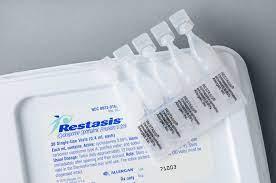cycloSPORINE (EENT) (Monograph)
Brand name: Restasis
Drug class: Anti-inflammatory Agents
Introduction
Topical immunomodulator; systemic immunosuppressive agent.
Uses for cycloSPORINE (EENT)
Keratoconjunctivitis Sicca
Used to increase tear production in adults whose tear production presumably is suppressed secondary to ocular inflammation related to keratoconjunctivitis sicca.
Increased tear production not observed in patients already receiving topical anti-inflammatory agents or using punctal plugs.
cycloSPORINE (EENT) Dosage and Administration
Administration
For ophthalmic use only. Not for injection. Not for subconjunctival injection or introduction directly into the anterior chamber of the eye.
Ophthalmic Administration
Apply topically to the eye as an ophthalmic emulsion.
Avoid contamination of emulsion container.
Invert unit-dose vial a few times before use to obtain a uniform, opaque, white emulsion.
Preservative-free emulsion is for single use only in one or both eyes; discard any unused portion immediately after administration.
Remove contact lenses prior to administration; may reinsert lenses 15 minutes after dose.
When used concomitantly with artificial tears, administer ophthalmic preparations at least 15 minutes apart.
Dosage
Adults
Keratoconjunctivitis Sicca
Ophthalmic
1 drop of a 0.05% emulsion into each eye twice daily, approximately 12 hours apart.
Cautions for cycloSPORINE (EENT)
Contraindications
-
Known hypersensitivity to cyclosporine or any ingredient in the formulation.
-
Active ocular infections.
Warnings/Precautions
Warnings
Safety and efficacy not established in patients with history of herpes keratitis.
Specific Populations
Pregnancy
Category C.
Lactation
Distributed into milk after systemic administration; it is not known whether distributed into milk after topical application to the eye. Caution advised if used in nursing women.
Pediatric Use
Safety and efficacy not established in children <16 years of age.
Geriatric Use
No substantial differences in safety and efficacy relative to younger adults.
Common Adverse Effects
Ocular burning, conjunctival hyperemia, discharge, epiphora, ocular pain, foreign body sensation, pruritus, stinging, visual disturbance (e.g., blurring).
Drug Interactions
No formal drug interaction studies to date.
cycloSPORINE (EENT) Pharmacokinetics
Absorption
Bioavailability
Blood cyclosporin A concentrations were below quantitation limit (0.1 ng/mL) after topical application of cyclosporine 0.05% emulsion to the eye twice daily for up to 12 months. No detectable drug accumulation in blood during 12 months of treatment.
Distribution
Extent
Not known whether distributed into milk after topical application to the eye.
Stability
Storage
Ophthalmic
Emulsion
15–25°C.
Actions
-
Exact mechanism of action not fully elucidated, but thought to act as a partial immunomodulator with anti-inflammatory effects when administered topically to the eye.
-
Topical application to the eye reduces cell-mediated inflammatory responses associated with inflammatory ocular surface diseases.
-
Exhibits immunosuppressive activity when administered systemically.
Advice to Patients
-
Importance of learning and adhering to proper administration techniques to avoid contamination of the product.
-
Importance of administering ophthalmic emulsion immediately after opening single-use vial and discarding any unused portion immediately after administration.
-
Importance of not wearing contact lenses in presence of decreased tear production. If contact lenses are worn, importance of removing lenses prior to administration and delaying reinsertion of lenses for 15 minutes after instillation.
-
Importance of women informing clinicians if they are or plan to become pregnant or to breast-feed.
-
Importance of informing clinicians of existing or contemplated concomitant therapy, including prescription and OTC drugs.
-
If using artificial tears and ophthalmic cyclosporine, importance of allowing at least 15 minutes to elapse between administration.
-
Importance of informing patients of other important precautionary information. (See Cautions.)
Additional Information
The American Society of Health-System Pharmacists, Inc. represents that the information provided in the accompanying monograph was formulated with a reasonable standard of care, and in conformity with professional standards in the field. Readers are advised that decisions regarding use of drugs are complex medical decisions requiring the independent, informed decision of an appropriate health care professional, and that the information contained in the monograph is provided for informational purposes only. The manufacturer’s labeling should be consulted for more detailed information. The American Society of Health-System Pharmacists, Inc. does not endorse or recommend the use of any drug. The information contained in the monograph is not a substitute for medical care.
Preparations
Excipients in commercially available drug preparations may have clinically important effects in some individuals; consult specific product labeling for details.
Please refer to the ASHP Drug Shortages Resource Center for information on shortages of one or more of these preparations.
|
Routes |
Dosage Forms |
Strengths |
Brand Names |
Manufacturer |
|---|---|---|---|---|
|
Ophthalmic |
Emulsion |
0.05% |
Restasis (preservative-free) |
Allergan |
AHFS DI Essentials™. © Copyright 2025, Selected Revisions June 10, 2024. American Society of Health-System Pharmacists, Inc., 4500 East-West Highway, Suite 900, Bethesda, Maryland 20814.
Reload page with references included
Related/similar drugs
More about cyclosporine ophthalmic
- Check interactions
- Compare alternatives
- Pricing & coupons
- Reviews (295)
- Side effects
- Dosage information
- During pregnancy
- Drug class: miscellaneous ophthalmic agents
- Breastfeeding
- En español
Patient resources
- Cyclosporine ophthalmic drug information
- Cyclosporine (Ophthalmic) (Advanced Reading)
- Cyclosporine (Ophthalmic) Single-Dose Vials
Professional resources
Other brands
Restasis, Vevye, Cequa, Verkazia

